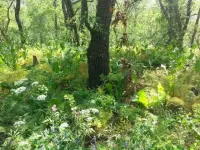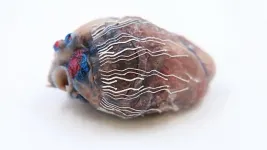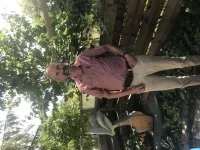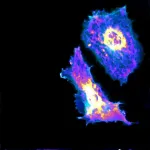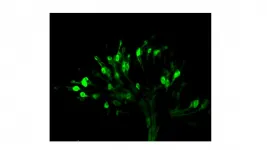(Press-News.org) How much do traditional practices contribute to the protection of local biodiversity? Why and how are sacred groves locally valued and protected, and how can this be promoted and harnessed for environmental protection? Working together with the University of Kurdistan, researchers of the University of Göttingen and the University of Kassel have examined the backgrounds of this form of local environmental protection in Baneh County, Iran.
"Around the world, local communities are voluntarily protecting certain parts of their surroundings due to religious reasons - be it in Ethiopia, Morocco, Italy, China or India", reports Professor Tobias Plieninger, head of the section Social-ecological Interactions in Agricultural Systems at the universities of Kassel and Göttingen. Sacred natural sites are places where traditional myths and stories meet local ecological knowledge and environmental protection. Beyond state-based protection programs, these form a network of informal nature reserves.
In the contested border areas between Iran and Iraq, state-run environmental protection programs are often failing, while natural resources are under a lot of pressure. Even in such areas of conflict, patches of highly biodiverse woodlands still exist thanks to informal conservation traditions - in the form of decades-old sacred natural sites, some of which are known as the 'sacred groves'.
In the Middle East, sacred groves are quite common, but there has been very little research into these biocultural hotspots. They usually belong to a Mosque and serve as village cemeteries, the use of which is strictly regulated. Even though they usually cover only a small area - 1 hectare on average - they are comparatively rich in biodiversity, provide numerous ecosystem services and are of great cultural and spiritual importance to local communities.
Local people regard them as the abodes of their ancestors. Dr Zahed Shakeri, who accompanied the project as a post-doc researcher and grew up in the region himself, reports on the numerous myths and legends that surround these sites and demand a careful maintenance as well as respectful behavior. "Our research group developed a fascination for the botanical treasures of these sites," Plieninger tells. In a vegetation study, they found out that the taxonomic diversity in sacred groves is much higher than in neighboring cultivated lands. The vegetation composition, too, is fundamentally different here.
"The 22 sacred groves examined comprised 20% of the flora of the whole region. Moreover, they host multiple rare and endangered plants, and represent complex niches for threatened animals", Shakeri reports. "Due to this taxonomic diversity, sacred groves can serve as an important complement to formally protected areas in the region, and as baselines in their reconstruction." Today, due to changes in customary rights, population growth and the loss of traditional faiths, the number and condition of such sacred natural sites are decreasing around the world. Thus, local people's perceptions regarding sacred groves as well as the reasons for their relatively good condition in the region were also subject of this research.
On the basis of interviews with 205 residents from 25 villages, the research group identified people's key motivations for the areas' protection: in particular spiritual values, the preservation of cultural and spiritual heritage as well as of local biodiversity played a role here. Furthermore, the importance of taboos became clear, which particularly prohibit the use of natural resources (for instance forest clearance, hunting and livestock grazing) and road construction, but also regulate the general behavior within these sites.
Even though these social values and taboos are considered relatively stable in the province of Kurdistan, the interviewees repeatedly referred to the threatened situation of the groves in the region. Especially elderly and rural people, women and people with traditional lifestyles were regarded as the holders of these values and taboos. "Protection programs could support these groups to defend and revive their customs. At the same time, young and urban people with modern lifestyles represent an important target group for awareness-raising," Shakeri summarizes.
The example of sacred groves demonstrates that social dynamics and especially cultural values deserve greater attention in environmental protection: "Such a biocultural approach to conservation that considers different worldviews and knowledge systems, could translate social taboos and the related land-use practices into socially acceptable and environmentally effective conservation outcomes", Plieninger concludes.
INFORMATION:
On the online blog of the research group Social-Ecological Interactions in Agricultural Systems: https://medium.com/people-nature-landscapes
The (English-language) blog articles:
Sacred Groves in Kurdistan: Biodiversity, Locally Preserved
Sacred Groves as a Safe Shelter for Biodiversity and Culture in Kurdistan
Original publications:Plieninger, T., Quintas-Soriano, C., Torralba, M., Muhammadi Sammani, K., & Shakeri, Z. 2020.Social dynamics of values, taboos and perceived threats around sacred groves in Kurdistan, Iran. People and Nature 2: 1237-1250 AND
Shakeri, Z., Mohammadi-Samani, K., Bergmeier, E. & Plieninger, T. 2021. Spiritual values shape taxonomic diversity, vegetation composition, and conservation status in woodlands of the Northern Zagros, Iran. Ecology and Society 26, art. 30.
https://doi.org/10.5751/ES-12290-260130
Contact:
Professor Tobias Plieninger
Head of Section Social-Ecological Interactions in Agricultural Systems
Email: plieninger@uni-kassel.de
Imke Horstmannshoff
Project Management & Communication
Section Social-Ecological Interactions in Agricultural Systems
Email: imke.horstmannshoff@uni-kassel.de
Researchers at the University of Texas Medical Branch have observed that SARS-CoV-2, the virus that causes COVID-19, can infect the testes of infected hamsters. The findings, published in the journal Microorganisms, could help explain symptoms some men with COVID-19 have reported and have important implications for men's health.
As the pandemic goes on, clinicians continue to report their findings that COVID-19 affects more than just the lungs. Some patients have reported testicular pain and some reports have shown decreases in testosterone, a key hormone produced in the ...
Below please find a summary for a new article that will be published today in Annals of Internal Medicine. The summary is not intended to substitute for the full article as a source of information. This information is under strict embargo and by taking it into possession, media representatives are committing to the terms of the embargo not only on their own behalf, but also on behalf of the organization they represent.
FDA advisory panelist outlines numerous issues with aducanumab's accelerated approval for Alzheimer's disease
Abstract: https://www.acpjournals.org/doi/10.7326/M21-2603
URL ...
WEST LAFAYETTE, Ind. – Surgeons may soon be able to localize critical regions in tissues and organs during a surgical operation thanks to a new, patent-pending Purdue University biosensor that can be printed in 3D using an automated printing system.
Chi Hwan Lee created the biosensor, which allows for simultaneous recording and imaging of tissues and organs during a surgical operation. Lee is the Leslie A. Geddes Assistant Professor of Biomedical Engineering in the Weldon School of Biomedical Engineering and assistant professor of mechanical engineering. Lee also has a courtesy appointment in materials engineering.
"Simultaneous recording and imaging could be useful during heart surgery in localizing critical regions and guiding ...
In the realm of social media, anti-science views about COVID-19 align so closely with political ideology -- especially among conservatives -- that its predictability offers a strategy to help protect public health, a new USC study shows.
Resistance to science, including the efficacy of masks and vaccines, poses a challenge to conquering the coronavirus crisis. The goal of achieving herd immunity won't happen until society achieves consensus about science-based solutions.
The USC study's machine-learning assisted analysis of social media communications offers policymakers and public health officials new tools to anticipate shifts in attitudes ...
A rare parasitic infection imported from Europe continues to take root in Alberta, Canada. The province is now the North American hotspot for human alveolar echinococcosis (AE), which takes the form of a growth in the liver, causing serious and potentially deadly health complications.
A END ...
Only 2% of vehicles are electrified to date, but that is projected to reach 30% in 2030. A key toward improving the commercialization of electric vehicles (EVs) is to heighten their gravimetric energy density - measured in watt hours per kilogram - using safer, easily recyclable materials that are abundant. Lithium-metal in anodes are considered the "holy grail" for improving energy density in EV batteries compared to incumbent options like graphite at 240 Wh/kg in the race to reach more competitive energy density at 500 Wh/kg.
Yan Yao, Cullen Professor of electrical ...
MIAMI--In a new analysis on managed retreat--the climate adaptation response of moving people and property out of harm's way--researchers explore what it would take for managed retreat to be supportive of people and their priorities. A key starting point is considering retreat alongside other responses like coastal armoring and not just as an option of last resort.
In a new paper in the journal Science, University of Miami (UM) Rosenstiel School of Marine and Atmospheric Science researcher Katharine Mach argues that managed retreat should be viewed as a proactive option that can support communities and livelihoods in the face of climate change.
"Managed retreat ...
The surface of a material often has properties that are very different from the properties within the material. For example, a non-conducting crystal, which actually exhibits no magnetism, can show magnetisation restricted to its surface because of the way the atoms are arranged there. These distinct properties at interfaces and surfaces of materials often play a key role in the development of new functional components such as optoelectronic chips or sensors and are therefore subject to extensive research. An international research team from the University of Göttingen, the Max Planck Institute for Biophysical Chemistry Göttingen and the National Research Council Canada has now succeeded in investigating the surfaces of transparent crystals using ...
Understanding cellular metabolism - how a cell uses energy- could be key to treating a wide array of diseases, including vascular diseases and cancer.
While many techniques can measure these processes among tens of thousands of cells, researchers have been unable to measure them at the single-cell level.
Researchers at the University of Chicago's Pritzker School of Molecular Engineering and Biological Sciences Division have developed a combined imaging and machine learning technique that can, for the first time, measure a metabolic process at both the cellular and sub-cellular levels.
Using a genetically encoded biosensor paired with artificial intelligence, ...
PHILADELPHIA - Sour taste does not have the nearly universal appeal that sweet taste does. Slightly sour foods or drinks such as yogurt and lemon juice are yummy to many, but such highly sour foods as spoiled milk are yucky, even dangerous. Like humans, many other animals, including insects, prefer slightly acidic over very acidic foods.
Evolutionary biologists surmise that the need for sour detection to be finely tuned is a two-sided coin: slightly acidic foods can enhance digestion and stimulate saliva production; relative sour-to-sweet taste can signal optimal ripeness of fruit; and extremely sour food, as with bitter taste, is a warning to what not to ingest. However, despite this usefulness, how do animals discern different concentrations ...
